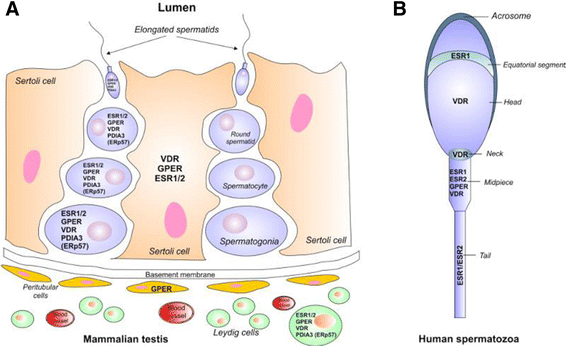Interactions between oestrogen and 1α,25(OH)2-vitamin D3 signalling and their roles in spermatogenesis and spermatozoa functions
- PMID: 28491323
- PMCID: PMC5421336
- DOI: 10.1186/s12610-017-0053-z
Interactions between oestrogen and 1α,25(OH)2-vitamin D3 signalling and their roles in spermatogenesis and spermatozoa functions
Abstract
Oestrogens and 1α,25(OH)2-vitamin D3 (1,25-D3) are steroids that can provide effects by binding to their receptors localised in the cytoplasm and in the nucleus or the plasma membrane respectively inducing genomic and non-genomic effects. As confirmed notably by invalidation of the genes, coding for their receptors as tested with mice with in vivo and in vitro treatments, oestrogens and 1,25-D3 are regulators of spermatogenesis. Moreover, some functions of ejaculated spermatozoa as viability, DNA integrity, motility, capacitation, acrosome reaction and fertilizing ability are targets for these hormones. The studies conducted on their mechanisms of action, even though not completely elicited, have allowed the demonstration of putative interactions between their signalling pathways that are worth examining more closely. The present review focuses on the elements regulated by oestrogens and 1,25-D3 in the testis and spermatozoa as well as the interactions between the signalling pathways of both hormones.
L’œstradiol et la 1α,25(OH)2-vitamin D3 (1,25-D3 ou calcitriol) sont respectivement la forme la plus active des œstrogènes et la forme hormonalement active de la vitamine D. Ces stéroïdes peuvent exercer leurs effets biologiques après fixation à des récepteurs localisés dans le cytoplasme et le noyau (récepteurs dit nucléaires) ou par fixation à des récepteurs localisés à la membrane plasmique (récepteurs membranaires) à l’origine d’effets appelés génomiques et non génomiques respectivement. Bien que les œstrogènes aient longtemps été considérés comme uniquement des hormones féminines, de nombreux travaux ont permis de montrer leur importance dans le bon déroulement de la spermatogenèse et la qualité des gamètes. De même, la 1,25-D3 est capable de réguler les fonctions testiculaires suggérant son importance dans la fertilité. Les études réalisées sur leurs mécanismes d’action, bien qu’ils ne soient pas complètement élucidés, ont permis de mettre en évidence des interactions entre les voies de signalisation de ces deux hormones. Cette revue est centrée sur les évènements régulés par les œstrogènes et la 1,25-D3 dans les testicules et les spermatozoïdes et les interactions entre leurs voies de signalisation.
Keywords: 1α,25(OH)2-vitamin D3 (1,25-D3); Oestrogen; Spermatogenesis; Spermatozoa; Steroid receptors.
Figures



Similar articles
-
1alpha,25-dihydroxy-24-oxo-16-ene vitamin D3, a metabolite of a synthetic vitamin D3 analog, 1alpha,25-dihydroxy-16-ene vitamin D3, is equipotent to its parent in modulating growth and differentiation of human leukemic cells.J Steroid Biochem Mol Biol. 1996 Dec;59(5-6):405-12. doi: 10.1016/s0960-0760(96)00134-3. J Steroid Biochem Mol Biol. 1996. PMID: 9010346
-
Oestrogens as apoptosis regulators in mammalian testis: angels or devils?Expert Rev Mol Med. 2015 Jan 27;17:e2. doi: 10.1017/erm.2014.25. Expert Rev Mol Med. 2015. PMID: 26258687 Review.
-
1alpha(OH)D3 One-alpha-hydroxy-cholecalciferol--an active vitamin D analog. Clinical studies on prophylaxis and treatment of secondary hyperparathyroidism in uremic patients on chronic dialysis.Dan Med Bull. 2008 Nov;55(4):186-210. Dan Med Bull. 2008. PMID: 19232159 Review.
-
Of Oestrogens and Sperm: A Review of the Roles of Oestrogens and Oestrogen Receptors in Male Reproduction.Int J Mol Sci. 2017 Apr 25;18(5):904. doi: 10.3390/ijms18050904. Int J Mol Sci. 2017. PMID: 28441342 Free PMC article. Review.
-
Vitamin D3 mediated regulation of steroidogenesis mitigates testicular activity in an aged rat model.J Steroid Biochem Mol Biol. 2019 Jun;190:64-75. doi: 10.1016/j.jsbmb.2019.03.016. Epub 2019 Mar 25. J Steroid Biochem Mol Biol. 2019. PMID: 30923019
Cited by
-
ERp57/PDIA3: new insight.Cell Mol Biol Lett. 2022 Feb 2;27(1):12. doi: 10.1186/s11658-022-00315-x. Cell Mol Biol Lett. 2022. PMID: 35109791 Free PMC article. Review.
-
Occurrence and reproductive roles of hormones in seminal plasma.Basic Clin Androl. 2017 Sep 8;27:19. doi: 10.1186/s12610-017-0062-y. eCollection 2017. Basic Clin Androl. 2017. PMID: 29046808 Free PMC article.
-
Immunonutrients involved in the regulation of the inflammatory and oxidative processes: implication for gamete competence.J Assist Reprod Genet. 2022 Apr;39(4):817-846. doi: 10.1007/s10815-022-02472-6. Epub 2022 Mar 30. J Assist Reprod Genet. 2022. PMID: 35353297 Free PMC article. Review.
-
Relationship between serum vitamin D concentration and parameters of gonadal function in infertile male patients.Curr Urol. 2024 Sep;18(3):237-243. doi: 10.1097/CU9.0000000000000075. Epub 2024 Sep 20. Curr Urol. 2024. PMID: 39219637 Free PMC article.
-
Serum estradiol levels in infertile men with non-obstructive azoospermia.Ther Adv Reprod Health. 2020 Jun 28;14:2633494120928342. doi: 10.1177/2633494120928342. eCollection 2020 Jan-Dec. Ther Adv Reprod Health. 2020. PMID: 32647832 Free PMC article.
References
-
- Chimento A, Sirianni D, Zolea F, Bois C, Delalande C, Andò S, et al. Gper and ESRs are expressed in rat round spermatids and mediate oestrogen-dependent rapid pathways modulating expression of cyclin B1 and Bax. Int J Androl. 2011;34(5 Pt 1):420–9. doi: 10.1111/j.1365-2605.2010.01100.x. - DOI - PubMed
LinkOut - more resources
Full Text Sources
Other Literature Sources
Research Materials

